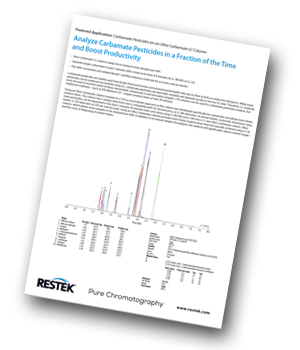Restek has produced an application note demonstrating how to analyse carbamate pesticides in a fraction of the time to boost productivity.
 Introduction
Introduction
Carbamate pesticides are widely used insecticides that pose human and environmental health risks due to their activity as endocrine disruptors. While many pesticides can be analysed successfully using GC, carbamate pesticides are thermally unstable and degrade quickly in the hot GC inlet. Therefore, LC methods must be used to monitor levels of these semivolatile compounds in soil and water samples. C18 columns can be used for carbamate pesticides analysis, but traditional methods—such as EPA Method 531—require analysis times of over 20 minutes.
Method
Using an Ultra Carbamate column instead of a C18 is a much better approach as this column was developed specifically for carbamates and allows much faster analysis times. The column has a unique selectivity and is compatible with UV, fluorescence, or LC-MS detection. Commonly monitored carbamate pesticides can be separated in less than 5 minutes (8 minutes total cycle time) using LC-MS/MS and a 100 mm x 2.1 mm Ultra Carbamate column. Alternately, LC-UV detection at 220 nm may be used. Using an Ultra Carbamate column provides much faster analysis times than are typically achieved using a C18 column, which allows more samples to be analysed per shift. In addition to increased sample throughput, this analysis will significantly reduce solvent usage — and the costs of disposing of solvent waste.
Download this application note and learn:
• How Ultra Carbamate LC columns equip you to analyse more samples per shift.
• How to separate target carbamates in just 5 minutes with a total cycle time of 8 minutes by LC-MS/MS or LC-UV.
• How by pairing with convenient and reliable Restek® certified reference materials accurate and precise results can be obtained.




